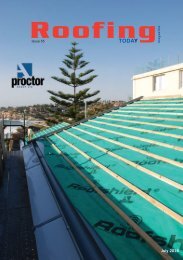Roofing
2kZ2j9o
2kZ2j9o
You also want an ePaper? Increase the reach of your titles
YUMPU automatically turns print PDFs into web optimized ePapers that Google loves.
Facades<br />
Future Facade Design<br />
Simon Gregory, Business Development Manager at Proteus Facades, looks at how advances in<br />
lightweight, rainscreen cladding systems are changing building design.<br />
Facades, being the outward and most visible<br />
element of a building, receive more than their<br />
fair share of attention. As such there has<br />
been much innovation in their design and<br />
aesthetic qualities over the last few years.<br />
In its strictest sense, a building envelope is a<br />
combination of different levels of<br />
transparency that has evolved from a binary<br />
classification – either solid wall or window –<br />
to one where the boundaries between inside<br />
and outside are blurred. For example,<br />
perforated and mesh façade panels mean that<br />
it is no longer possible to clearly define<br />
where the inside ends and the outside<br />
begins.<br />
Whereas we might have seen the façade as<br />
simply a barrier that protects the building<br />
and its contents, the reality is one where it<br />
has evolved into a transient intersection<br />
between these two states of being. Aside<br />
from acting as the most visible part of the<br />
design, the façade sometimes, although less<br />
frequently now, has the task of presenting<br />
the building in a way that gives an overall<br />
idea of its purpose.<br />
For instance, use of rainscreen cladding<br />
systems made up of lightweight materials,<br />
including aluminium, zinc, copper alloys,<br />
stainless steel, ceramics or back painted<br />
glass panels, means that the outward<br />
appearance can be designed to be sensitive<br />
to the building’s immediate environment and<br />
setting. As a result, facades now play an<br />
important part in ensuring that the building<br />
design is appropriate to its environment and<br />
modern façade cladding materials have<br />
helped architects and designers to deliver<br />
this.<br />
Indeed, rainscreen façade systems can be<br />
added to – overclad – existing outdated<br />
buildings to transform and present them in a<br />
new light. Making an old building look like<br />
new in this way is one of the most effective<br />
means of reducing build schedules,<br />
minimising disruption and cutting the carbon<br />
footprint for your client.<br />
Facades, therefore, have evolved, and can<br />
now been seen as separate to the spatial<br />
layout of the building. In that sense, they<br />
have the ability to operate outside the influence of the internal elements and separate to the<br />
other mundane constructional elements. Modern rainscreen cladding systems have evolved to a<br />
stage where they now provide architects and designers with the freedom to create designs that<br />
can stand up to the closest scrutiny in their own right.<br />
Sitting confidently<br />
Take for example SECC & Hydro Arena Car Park in Glasgow, a striking building that belies its<br />
more workaday purpose as a multi storey car park. Proteus’ cladding systems deliver an<br />
aesthetic that enables the car park to sit confidently alongside neighbouring landmark buildings<br />
such as Scottish Exhibition and Conference Centre (SECC), and the newly completed SSE Hydro<br />
auditorium.<br />
The facade materials were chosen because they complement the already established SECC. The<br />
main elevations are clad with a Marine Grade Mill Finished Aluminium, as used on the SECC,<br />
but with a distinctive bespoke perforated pattern. The panel support system was designed with<br />
vertical mullions spanning floor to floor, removing the need for secondary steel work and<br />
structural supports, which assisted the design team in complex geometrical areas like the spiral<br />
car ramps. The design process focused on ensuring that no fixings were visible or accessible<br />
from within the car park and that all sight lines remained as clean as possible.<br />
Modern rainscreen façade systems have the ability to soften the boundaries between a building<br />
and its environment and, as we can see from this project in Glasgow, provide cladding<br />
contractors and designers with the tools to transform the most mundane buildings into<br />
something far more striking.<br />
For more information on Proteus Facades, visit: www.proteusfacades.com or call: 0151 545 5075.<br />
Page 14<br />
<strong>Roofing</strong> Today<br />
Enquiry 7




